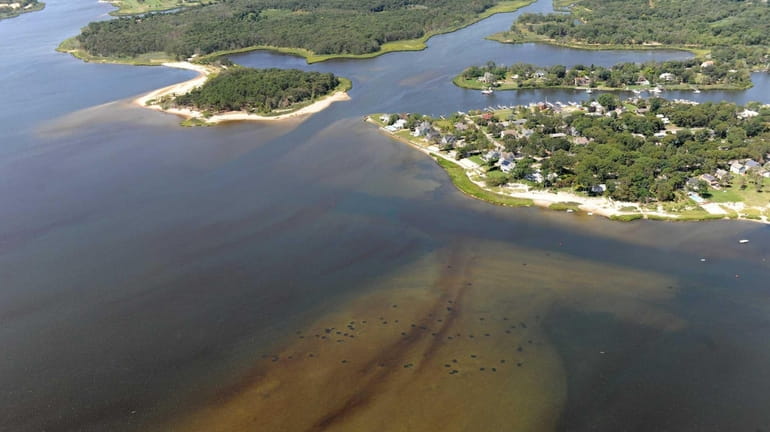Officials: Toxic rust tide returns to East End

The collection of algae, which gets its name from the brown and orange hue that upon its arrival, replaces the clear blue tint on the water's surface, has been detected in the west end of the Peconic Estuary and Shinnecock and Flanders bays (above), said Christopher Gobler, a professor at the Stony Brook University School of Marine and Atmospheric Sciences. (Aug. 14, 2013) Credit: Doug Kuntz
A toxic rust tide caused by human waste, farm fertilizer and other pollutants, has returned for the 10th straight year to the environmentally fragile wildlife estuaries and salt water bays on Long Island's east end, officials said.
The collection of algae, which gets its name from the brown and orange hue that upon its arrival, replaces the clear blue tint on the water's surface, has been detected in the west end of the Peconic Estuary and Shinnecock and Flanders bays, said Christopher Gobler, a professor at the Stony Brook University School of Marine and Atmospheric Sciences.
The algae can kill fish in hours, and shellfish in days, he said.
At the Peconic Estuary, the algae was detected at densities exceeding 10,000 cells per milliliter. At Shinnecock and Flanders, densities exceeded 1,000 cells per milliliter in the bays as well as their tributaries like Meetinghouse Creek, Gobler said, adding that 500 cells per milliliter can be deadly to marine life.
It's been the same every summer since 2004, Gobler said. Before then, the rust tide was never reported in Long Island waters.
The estuary forms at the end of the 15-mile long Peconic River, which stretches through farmland, wooded areas and the town of Riverhead.
Gobler said it's possible the organism was newly introduced to the area in 2004 or always existed but nitrogen levels, which intensify the algae blooms, happened to grow to ideal levels. Nitrogen can be found in urine and fertilizer, and can pollute waterways when waste water is not treated properly, Gobler said.
"It's here and it's not going away," he said of the rust tide.
The lethalness of the latest bloom will depend on its duration, Gobler said. It is expected to spread in coming weeks, typically extending into fall or until water temperatures drop below 60 degrees.
The organism makes cysts, or seeds, which sit at the bottom of the bay and emerge each summer to start a bloom. At the end of the bloom, they turn back into cysts and once again settle to the bay bottom, allowing them to return year after year.
In May, Peconic Baykeeper, a Quogue-based nonprofit, sued the New York State Department of Environmental Conservation for failing to protect surface waters from sewage pollution. The group also filed a notice of intent to sue against Stony Brook Southampton and the state office of Parks, Recreation and Historic Preservation in July for the same reason, said Kevin McAllister, the group's president.
He said the rust tide doesn't just do damage to marine life.
Dirty water with fewer fish could mean fewer tourists, he said. Instead, tourists could take their business to the New Jersey shore or Cape Cod.
"A dead bay is not OK," McAllister said. "The public at large has to start to rally and demand attention from government officials."
